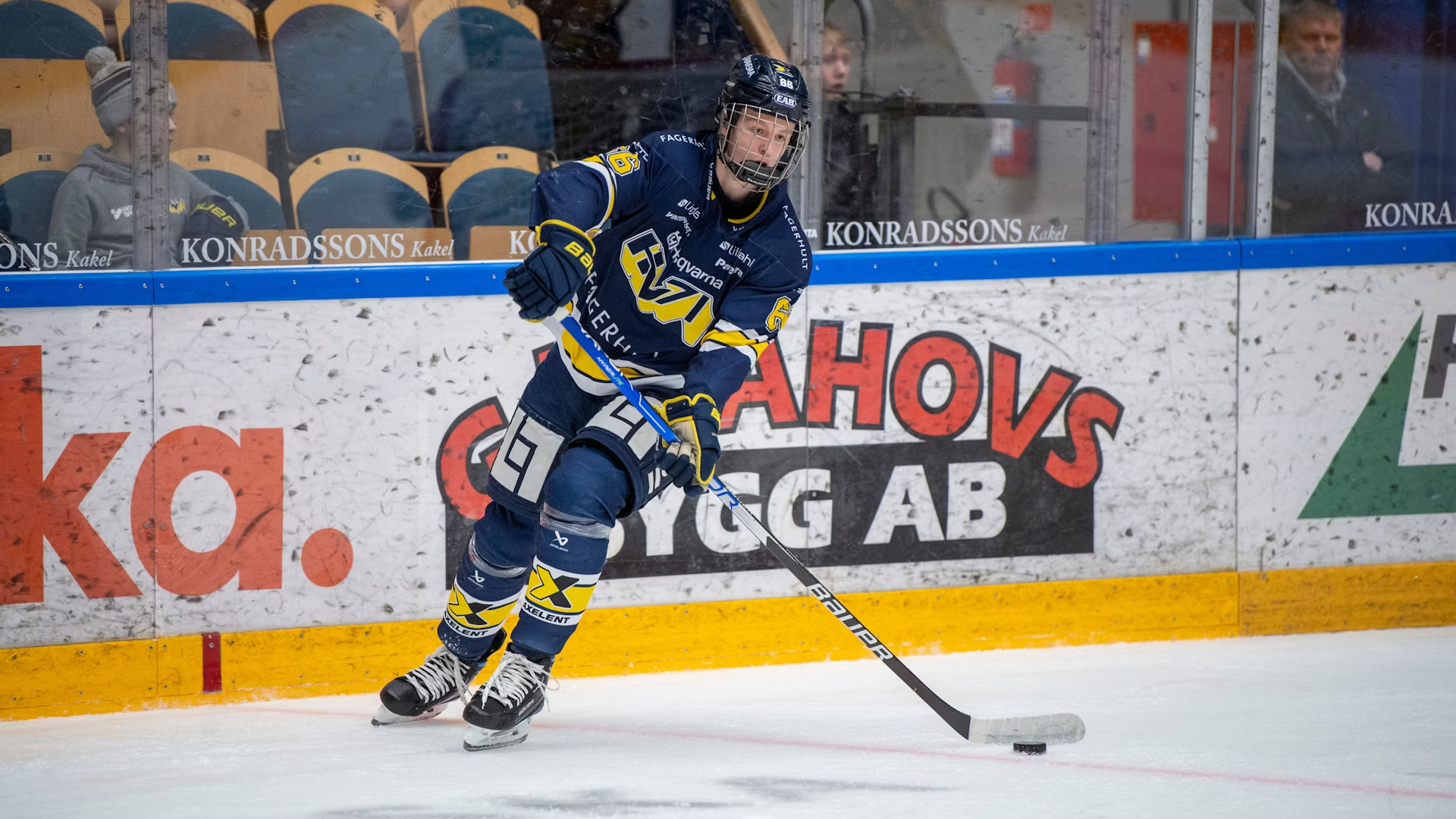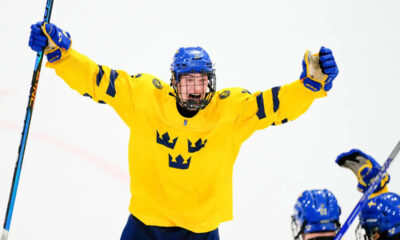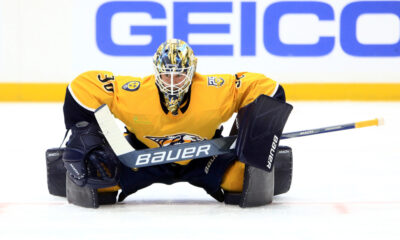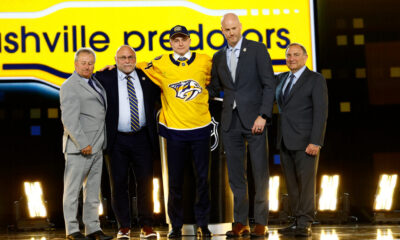The Nashville Predators added eight new prospects to the pipeline at the 2024 NHL Draft, including two forwards and a goalie in the later rounds. Each draftee brings a unique element to the organization, but Barry Trotz’s front office targeted prospects with plenty of translatable skills. I dug into each player with video analysis of their strengths, weaknesses, and projectability.
Viggo Gustafsson | D | HV71 (J20 Nationell) | 77th overall
The only defender Nashville selected at the 2024 NHL Draft, Viggo Gustafsson was born less than a week before being eligible for the 2025 NHL Draft. Despite being one of the younger prospects in this class, he showed plenty of skill at the U20 level in Sweden last year. Standing at 6’2″, the left-shot defender spent all but five games with HV71’s J20 squad, posting three goals and 19 points in 41 games. He also joined Sweden for the U18 World Junior Championship (WJC), adding an assist in seven contests.
Some have criticized this pick for being a reach or settling for a defensive defender, but I don’t think that’s a fair characterization of his game. Gustafsson is dynamic in playing his position. He opens his body wide to opposing puck carriers, limiting how they can enter the zone. He stays close to his man without abandoning the net front and pounces when the time is right to pin an opponent against the wall.
In front of his net, Gustafsson attacks potential screens with jabs and cross-checks. He keeps his head on a swivel, monitoring when he’ll need to shift to the corner or jump on a loose puck. And while he infrequently leads his team’s transition, he scans the ice well and picks opportune times to jump into the rush.
Gustafsson’s pivot timing will need to improve in both his processing and foot speed. Still, at the junior level, he showed a good ability to recover and disrupt plays—especially with an active, long stick.
The Swedish defender, in my estimation, doesn’t get enough credit for the physicality in his game. He can be smothering along the wall, dislodging possession with plenty of shoves and the leverage of his frame.
The success of Gustafsson’s defensive play, and his ability to cover so much ground so quickly, is due mostly to his wingspan and his skating skills. He lacks an elite accelerating step, and his first few strides can be a bit choppy, but the blueliner’s mechanics are solid; he should grade out as an NHL-average skater. On top of that, he demonstrated good four-way mobility as he developed this season.
The major drawback to Gustafsson’s game is his offense or lack thereof. It’s not that he’s without any puck skills; in fact, I think his hands are pretty good. When he collects the puck in his end, he rarely panics under pressure. He fends off forecheckers with his feet and uses his frame for successful puck management; all the while, he’s looking up ice for the best pass. And that’s just the thing: despite good vision, decent puck skills, and poise with possession, Gustafsson seldom leads the rush and is rarely a shooter. He prefers long stretch passes and distributions from the point, which is completely fine for now. But to up his game at higher levels, he’ll need more reps in puck movement.
Despite the groaning over this pick, Viggo Gustafsson has a lot of tools that could help him play in the NHL one day. He’s got a great foundation to his defensive game and doesn’t like the skills to be a decent two-way threat lower down the lineup. Next season will be a big opportunity to show he’s willing to be a number-one, puck-moving defender at the junior level.
Jakub Milota | G | Cape Breton Eagles | 99th overall
Taking their only goalie of the night, the Nashville Predators selected Jakub Milota in the fourth round of the NHL Draft. The Czech netminder stands at 6’1″ and spent last season with the Cape Breton Eagles of the QMJHL. In 33 games, he posted a 0.905 save percentage and represented Czechia at the U18 WJC, showing a far worse outing against more daunting competition.
Jakub Milota looks the part of many junior goalies these days. There’s no significant flaw to his game, but he hasn’t developed an elite skill either. And like many of his peers, you’ll find him defaulting to the Reverse-VH (RVH) position most shifts (even as the trend has sparked a broader conversation of its consequences).
Milota tracks the puck well and responds with timely shuffles or T-pushes when necessary —never straying too far to one side or another.
While I wouldn’t describe Milota as overly aggressive at the top of his crease, he demonstrated good vision against screens in his rookie season in juniors. His butterfly slides show solid agility, and while he’s largely positionally sound, Milota naturally got caught in a few mistakes when trying to set his angles against shooters.
As happens with every goalie, some nights, Milota’s angles were just a bit off—usually when challenging shooters in open space. His glove and blocker sides were exploited at similar rates.
What impresses me most about Milota’s game is not just his lateral speed but his ability to seal the bottom of the net at the same time. When you’re trying desperately to get across the crease as fast as possible, holes tend to open up beneath your leg pads. But many nights, Milota stonewalled plenty of shooters trying to jam the puck home after making him move side-to-side.
It’s hard to say one way or another whether Jakub Milota can make it to the NHL, and that’s not necessarily an indictment on his game. But Nashville’s goalie pipeline is thin, and he becomes another chance to develop someone behind Juuse Saros or Yaroslav Askarov.
Viktor Nörringer | W | Frölunda HC J20 (J20 Nationell) | 127th overall
Maybe the most intriguing of Nashville’s newest prospects from the 2024 NHL Draft is Viktor Nörringer. Taken in the fourth round, Nörringer was on no public draft boards, and I hadn’t watched him play (at least intentionally) all season. But in reviewing his game tape, there’s plenty of reason to think he has some upside. The 6’3″ winger split his time between the U18 and U20 levels in Sweden this year. He was dominant in the former, scoring 20 goals and 45 points in just 23 games; in his 25-game J20 Nationell debut, Nörringer pitched in eight goals and 12 points for Frölunda HC.
The first thing you probably notice when watching Nörringer’s game is his size and his skating. He looks all of his 6’3″ frame (maybe bigger), and his skating looks a bit awkward. His stride extensions are indeed short, and his crossover steps lack explosion (mostly due to inadequate knee bend). But Nörringer still reaches a pretty good top speed and covers tons of ice; despite the hiccups in his mechanics, he doesn’t tend to fall behind the play when his team is attacking.
Nörringer moves well with the puck, attacking defenders head-on and forcing them to take on his big frame. His puck protection skills could improve, and with that his processing speed, but overall he looked pretty well-adjusted for a rookie at the U20 level. Beyond that, far too many of Nörringer’s type of forwards sit on the perimeter of the offensive zone, waiting for the play to come to them; he doesn’t. He’ll dig for pucks along the boards and muscle his way to the front of the net to create his own scoring chances. Nörringer understands puck support positioning well and scans his playmaking options efficiently.
As I mentioned above, Nörringer’s puck protection skills could improve, but I think his handling is quite good. He’s confident as a puck carrier, cradling possession and drawing defenders in before striking. He won’t likely deke around the offensive zone, but he knows how to exploit passing lanes well.
When it comes to finishing talent, Nörringer has an absolute bomb of a shot. His one-timer is a serious threat on the power play, and his wrist and snapshots are quick, deceptive, and forceful. His release comes at a moment’s notice even from bad passes or on his back foot.
And just as importantly, Nörringer showed a willingness to play meaningful defense during his time in the J20 Nationell. His decision-making when it comes to zone exits could improve, but he manned his point well, won one-on-one races to the boards, and kept his head on a swivel to monitor breakout options.
There’s certainly more of a chance Viktor Nörringer becomes a top forward in Sweden than an impactful NHL player. But for such a young prospect, I’m already impressed by the details of his game and an offensive talent level that could be unleashed with added strength and improved skating.
Erik Påhlsson | F | Dubuque Fighting Saints (USHL) | 213th overall
With their final pick in the 2024 NHL Draft, Nashville took their first overage player: Erik Påhlsson. The 20-year-old winger hails from Sweden but spent the 2023-24 campaign with Dubuque in the USHL. After trouncing the U20 circuit in Sweden the two seasons prior, Påhlsson posted 28 goals and 72 points in 57 games in his rookie North American year. He’s off to the University of Minnesota in the fall to skate alongside Matthew Wood.
Erik Påhlsson (#23, white) scores for Dubuque.
You don’t score 28 goals in a season by accident. Erik Påhlsson has some serious skill and his best may be his ability to slide behind defenders undetected. The clip above showcases what a lot of his markers looked like this year: he plays a tight puck-support game off the rush, helps catalyze the cycle, and then slides into soft ice to bury the puck past the goalie. It’s genuinely uncanny how often this play happened; he’s simply got a nose for finding himself adequate time and space. And to be clear, if he’s going to succeed at higher levels, that’s exactly how he’ll need to score.
Påhlsson’s overall offensive skills are fine. He relies heavily on give-and-go hockey and has good vision to exploit when opponents leave passing lanes open. He’s ultimately more of a puck manager than a puck handler, and his finishing talent one-on-one is average at best.
The Swedish winger is a pretty effective forechecker, overcoming skating inadequacies with good angles, decent agility, and a good understanding of how to cut down time and space for opponents with his positioning.
I appreciate Påhlsson’s defensive game too. He played mostly on the wing this year but demonstrated a good ability to shift to the center position when called upon. He was disciplined with his in-zone coverage often noticing when a teammate was missing their mark and making up for it. He didn’t win every foot race around the zone or down the well, but he generally keeps a good position against puck carriers to make life a little more annoying.
Unfortunately, the main thing that will hold Påhlsson back from future success is his skating. His stride recoveries are decent, but his extensions lack depth, he buries his chest to the ice, his crossovers lack explosiveness, and he swings his arms wildly adding more work to his plate. At the junior level, his pace was mostly fine, but that will get increasingly exploited in college hockey without adjustments.

















